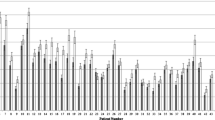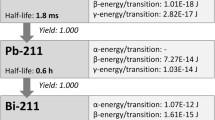Abstract
Background
Computed tomography (CT) is an imaging modality involving ionizing radiation. The presence of γ-H2AX foci after low to moderate ionizing radiation exposure has been demonstrated; however it is unknown whether very low ionizing radiation exposure doses from CT exams can induce γ-H2AX formation in vivo in young children.
Objective
To test whether very low ionizing radiation doses from CT exams can induce lymphocytic γ-H2AX foci (phosphorylated histones used as a marker of DNA damage) formation in vivo in young children.
Materials and methods
Parents of participating children signed a consent form. Blood samples from three children (ages 3–21 months) undergoing CT exams involving very low blood ionizing radiation exposure doses (blood doses of 0.22–1.22 mGy) were collected immediately before and 1 h post CT exams. Isolated lymphocytes were quantified for γ-H2AX foci by a technician blinded to the radiation status and dose of the patients. Paired t-tests and regression analyses were performed with significance levels set at P < 0.05.
Results
We observed a dose-dependent increase in γ-H2AX foci post-CT exams (P = 0.046) among the three children. Ionizing radiation exposure doses led to a linear increase of foci per cell in post-CT samples (102% between lowest and highest dose).
Conclusion
We found a significant induction of γ-H2AX foci in lymphocytes from post-CT samples of three very young children. When possible, CT exams should be limited or avoided by possibly applying non-ionizing radiation exposure techniques such as US or MRI.


Similar content being viewed by others
References
Frush DP, Donnelly LF (1998) Helical CT in children: technical considerations and body applications. Radiology 209:37–48
Larson DB, Johnson LW, Schnell BM et al (2011) Rising use of CT in child visits to the emergency department in the United States, 1995–2008. Radiology 259:793–801
Brenner DJ, Hall EJ (2007) Computed tomography — an increasing source of radiation exposure. N Engl J Med 357:2277–2284
Menoch MJ, Hirsh DA, Khan NS et al (2012) Trends in computed tomography utilization in the pediatric emergency department. Pediatrics 129:e690–697
No authors listed (2012) Growth rate of U.S. CT scans is slowing. Health Devices 41:332–333
Hsu WL, Preston DL, Soda M et al (2013) The incidence of leukemia, lymphoma and multiple myeloma among atomic bomb survivors: 1950–2001. Radiat Res 179:361–382
Su TT (2006) Cellular responses to DNA damage: one signal, multiple choices. Annu Rev Genet 40:187–208
Berrington de Gonzalez A, Mahesh M, Kim K-P et al (2009) Projected cancer risks from computed tomographic scans performed in the United States in 2007. Arch Intern Med 169:2071–2077
Cardis E, Vrijheid M, Blettner M et al (2007) The 15-country collaborative study of cancer risk among radiation workers in the nuclear industry: estimates of radiation-related cancer risks. Radiat Res 167:396–416
Berrington de Gonzalez A, Darby S (2004) Risk of cancer from diagnostic X-rays: estimates for the UK and 14 other countries. Lancet 363:345–351
Brenner D, Elliston C, Hall E et al (2001) Estimated risks of radiation-induced fatal cancer from pediatric CT. AJR Am J Roentgenol 176:289–296
ICRP (2005) Low-dose extrapolation of Radiation-related cancer risk. ICRP Publication 99. Ann ICRP 35
UNSCEAR (1993) United Nations Scientific Committee on the effects of atomic radiation. In: Nations U (ed) Sources, effects and risks of ionizing radiation. United Nations, New York
IARC (2000) Ionizing radiation, Part 1: X- and gamma-radiation and neutrons. IARC monographs on the evaluation of carcinogenic risks to humans. National Research Council, Committee on the Biological Effects of Ionizing Radiation, Health Risks from Exposures to Low Levels of Ionizing Radiation (BEIR VII), Lyon
UNSCEAR (2013) United Nations Scientific Committee on the Effects of Atomic Radiation: sources, effects and risks of ionizing radiation. In: Publications UN (ed) Scientific Annex B: Effects of radiation exposure of children. New York
Tubiana M, Feinendegen LE, Yang C et al (2009) The linear no-threshold relationship is inconsistent with radiation biologic and experimental data. Radiology 251:13–22
Feinendegen LE (2005) Evidence for beneficial low level radiation effects and radiation hormesis. Br J Radiol 78:3–7
Brenner DJ, Doll R, Goodhead DT et al (2003) Cancer risks attributable to low doses of ionizing radiation: assessing what we really know. Proc Natl Acad Sci U S A 100:13761–13766
Pearce MS, Salotti JA, Little MP et al (2012) Radiation exposure from CT scans in childhood and subsequent risk of leukaemia and brain tumours: a retrospective cohort study. Lancet 380:499–505
Mathews JD, Forsythe AV, Brady Z et al (2013) Cancer risk in 680,000 people exposed to computed tomography scans in childhood or adolescence: data linkage study of 11 million Australians. Br Med J 346:f2360
Sedelnikova OA, Rogakou EP, Panyutin IG et al (2002) Quantitative detection of (125) IdU-induced DNA double-strand breaks with gamma-H2AX antibody. Radiat Res 158:486–492
Rogakou EP, Pilch DR, Orr AH et al (1998) DNA double-stranded breaks induce histone H2AX phosphorylation on serine 139. J Biol Chem 273:5858–5868
Rogakou EP, Boon C, Redon C et al (1999) Megabase chromatin domains involved in DNA double-strand breaks in vivo. J Cell Biol 146:905–916
Pilch DR, Sedelnikova OA, Redon C et al (2003) Characteristics of gamma-H2AX foci at DNA double-strand breaks sites. Biochem Cell Biol 81:123–129
Paull TT, Rogakou EP, Yamazaki V et al (2000) A critical role for histone H2AX in recruitment of repair factors to nuclear foci after DNA damage. Curr Biol 10:886–895
Turner HC, Brenner DJ, Chen Y et al (2011) Adapting the gamma-H2AX assay for automated processing in human lymphocytes. 1. Technological aspects. Radiat Res 175:282–290
Lobrich M, Rief N, Kuhne M et al (2005) In vivo formation and repair of DNA double-strand breaks after computed tomography examinations. Proc Natl Acad Sci U S A 102:8984–8989
Redon CE, Nakamura AJ, Gouliaeva K et al (2010) The use of gamma-H2AX as a biodosimeter for total-body radiation exposure in non-human primates. PLoS One 5:e15544
Beels L, Bacher K, De Wolf D et al (2009) gamma-H2AX foci as a biomarker for patient X-ray exposure in pediatric cardiac catheterization: are we underestimating radiation risks? Circulation 120:1903–1909
Redon CE, Dickey JS, Bonner WM et al (2009) gamma-H2AX as a biomarker of DNA damage induced by ionizing radiation in human peripheral blood lymphocytes and artificial skin. Adv Space Res 43:1171–1178
Stamm G, Nagel HD (2002) CT-expo — a novel program for dose evaluation in CT. Röfo 174:1570–1576
Valentin J (2002) Basic anatomical and physiological data for use in radiological protection: reference values: a report of age- and gender-related differences in the anatomical and physiological characteristics of reference individuals. ICRP Publication 89. Ann ICRP 32:5–265
Fenech M (2000) The in vitro micronucleus technique. Mutat Res 455:81–95
Angelini S, Kumar R, Carbone F et al (2005) Micronuclei in humans induced by exposure to low level of ionizing radiation: influence of polymorphisms in DNA repair genes. Mutat Res 570:105–117
Andreassi MG, Ait-Ali L, Botto N et al (2006) Cardiac catheterization and long-term chromosomal damage in children with congenital heart disease. Eur Heart J 27:2703–2708
Bauchinger M (1995) Quantification of low-level radiation exposure by conventional chromosome aberration analysis. Mutat Res 339:177–189
Rothkamm K, Balroop S, Shekhdar J et al (2007) Leukocyte DNA damage after multi-detector row CT: a quantitative biomarker of low-level radiation exposure. Radiology 242:244–251
Beels L, Bacher K, Smeets P et al (2012) Dose-length product of scanners correlates with DNA damage in patients undergoing contrast CT. Eur J Radiol 81:1495–1499
Schlattl H, Zankl M, Becker J et al (2012) Dose conversion coefficients for paediatric CT examinations with automatic tube current modulation. Phys Med Biol 57:6309–6326
Brix G, Lechel U, Veit R et al (2004) Assessment of a theoretical formalism for dose estimation in CT: an anthropomorphic phantom study. Eur Radiol 14:1275–1284
Jost G, Golfier S, Pietsch H et al (2009) The influence of x-ray contrast agents in computed tomography on the induction of dicentrics and gamma-H2AX foci in lymphocytes of human blood samples. Phys Med Biol 54:6029–6039
Paterson A, Frush DP, Donnelly LF (2001) Helical CT of the body: are settings adjusted for pediatric patients? AJR Am J Roentgenol 176:297–301
Picano E (2004) Sustainability of medical imaging. Br Med J 328:578–580
Commission E (2001) Radiation protection 118 — referral guideline for imaging. Office for Official Publications of the European Communities, Luxembourg
Acknowledgments
We wish to thank the children and their parents who participated in the study. We would also like to thank Mr. Ronald Frick, MS, from the Gamma Corp. for his assistance in the CT parameters and calculations and Lynn Wilkens, PhD, for her statistical evaluation assistance. This study was funded by the University of Hawai’i Cancer Center Developmental Fund and the National Institute of Allergy and Infectious Diseases U19 AI067773 with the two senior authors (B.M.H and A.A.F.) as co-principal investigators and both contributing equally to this manuscript.
Conflicts of interest
None
Author information
Authors and Affiliations
Corresponding author
Rights and permissions
About this article
Cite this article
Halm, B.M., Franke, A.A., Lai, J.F. et al. γ-H2AX foci are increased in lymphocytes in vivo in young children 1 h after very low-dose X-irradiation: a pilot study. Pediatr Radiol 44, 1310–1317 (2014). https://doi.org/10.1007/s00247-014-2983-3
Received:
Revised:
Accepted:
Published:
Issue Date:
DOI: https://doi.org/10.1007/s00247-014-2983-3




